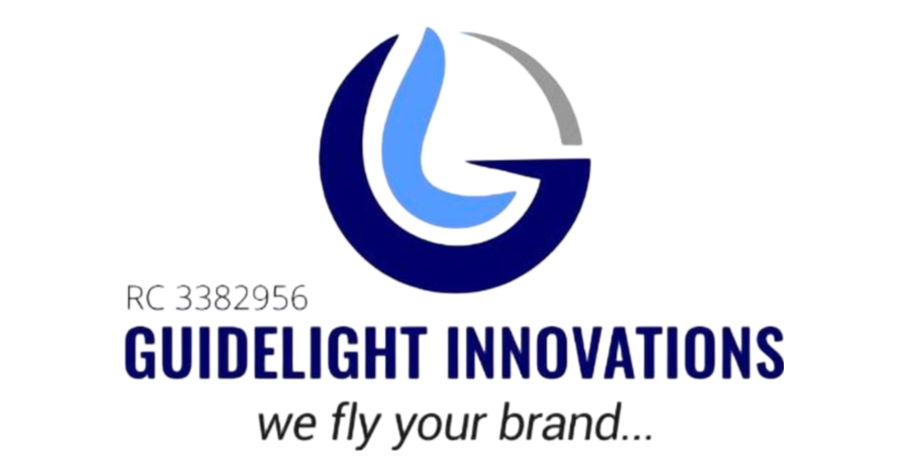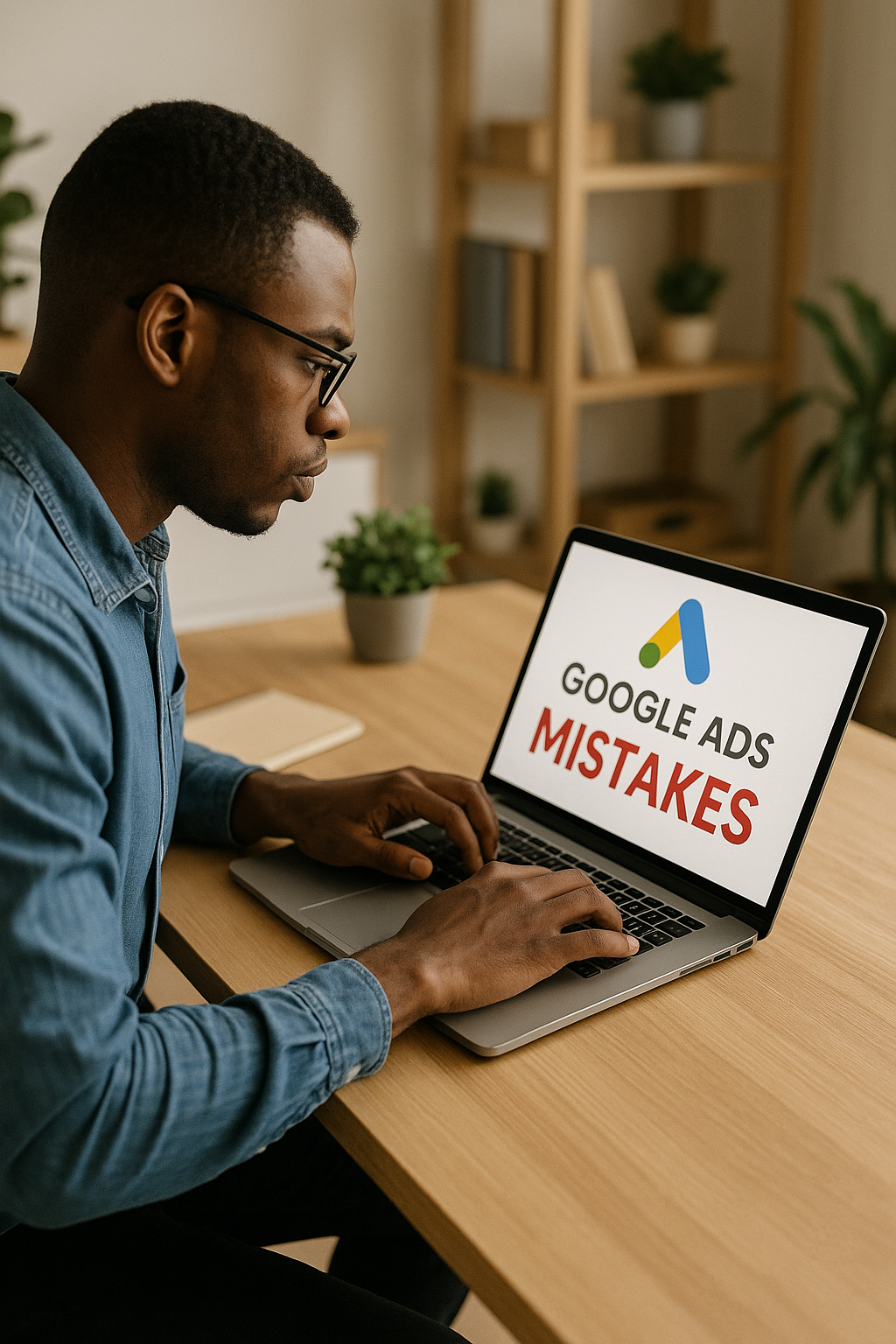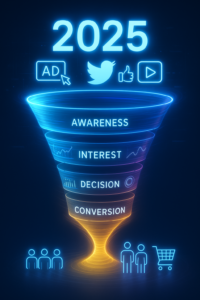Introduction
Google Ads represents one of the most powerful advertising platforms available to businesses today. With over 8.5 billion searches processed daily on Google, the potential to reach customers actively searching for your products or services is enormous. However, this potential comes with complexity, and many businesses waste thousands of dollars on poorly executed campaigns.
The harsh reality is that most businesses make critical Google Ads mistakes—mistakes that drain budgets, generate low-quality leads, and deliver disappointing returns on investment. According to industry research, businesses waste approximately 25% of their Google Ads budget on ineffective campaigns, poor targeting, or mismanaged strategies.
Whether you’re running Google Ads in-house or working with an agency, understanding these common pitfalls is essential for maximizing your advertising ROI. This comprehensive guide identifies the seven most costly mistakes businesses make with Google Ads and provides actionable solutions to fix them. By avoiding these errors and implementing best practices, you can transform underperforming campaigns into profit-generating marketing machines.
Mistake #1: Poor Keyword Strategy and Match Types
The Problem
One of the most fundamental mistakes businesses make is implementing a flawed keyword strategy. This manifests in several ways: targeting keywords that are too broad, using inappropriate match types, neglecting negative keywords, or failing to align keywords with search intent.
Broad match keywords without proper controls can trigger ads for irrelevant searches, wasting budget on clicks from users who have no intention of becoming customers. For example, a luxury watch retailer using broad match for “watches” might pay for clicks from users searching for “apple watch repair” or “how to wind watches”—searches with zero purchase intent for luxury timepieces.
Many businesses also ignore the power of long-tail keywords—longer, more specific search phrases that typically have lower competition and higher conversion rates. While “accounting services” generates massive search volume, “small business tax accounting services in Boston” attracts users much closer to making a purchase decision.
The Impact
Poor keyword strategy results in:
- Wasted ad spend on irrelevant clicks
- Low click-through rates (CTR) signaling poor relevance to Google
- High cost-per-click without corresponding conversions
- Lower Quality Scores leading to higher costs and worse ad positions
- Frustrated potential customers seeing irrelevant ads
The Solution
Conduct Thorough Keyword Research: Use tools like Google Keyword Planner, SEMrush, Ahrefs, or Ubersuggest to identify keywords your target customers actually use. Focus on commercial intent keywords—terms indicating readiness to purchase or engage services.
Leverage Different Match Types Strategically:
- Exact Match: Use for high-intent, proven converting keywords. Provides maximum control but limited reach.
- Phrase Match: Balances control with reach, showing ads when searches include your keyword phrase in order.
- Broad Match Modified: Use cautiously with close monitoring, ensuring you’re not triggering irrelevant searches.
- Broad Match: Generally avoid unless you have extensive negative keyword lists and monitoring.
Prioritize Long-Tail Keywords: Target specific, detailed search phrases that indicate strong purchase intent. These typically have lower cost-per-click and higher conversion rates than generic head terms.
Implement Comprehensive Negative Keywords: Build extensive negative keyword lists to prevent ads from showing for irrelevant searches. Review search term reports weekly to identify and exclude non-converting queries. Common negative keywords include “free,” “cheap,” “job,” “salary,” “DIY,” and “how to” (depending on your business model).
Organize Keywords into Tightly Themed Ad Groups: Group similar keywords together (ideally 5-20 per ad group) to create highly relevant ads and landing pages. This improves Quality Score and conversion rates.
Continuously Refine Based on Performance Data: Regularly analyze which keywords drive conversions and which waste budget. Pause or remove underperforming keywords and reallocate budget to top performers.
Mistake #2: Sending Traffic to Generic or Irrelevant Landing Pages
The Problem
Many businesses make the critical error of directing all Google Ads traffic to their homepage or generic service pages. When users click an ad for “emergency plumbing repair Dallas,” they expect to land on a page specifically about emergency plumbing services in Dallas—not a general plumbing company homepage requiring multiple clicks to find relevant information.
This disconnect between ad promise and landing page delivery creates friction, confusion, and abandonment. Users quickly hit the back button and click a competitor’s ad that delivers a more relevant experience. Google also monitors this behavior, and high bounce rates negatively impact your Quality Score, increasing costs and lowering ad positions.
The Impact
Generic or irrelevant landing pages cause:
- High bounce rates and low conversion rates
- Wasted ad spend on clicks that never convert
- Poor Quality Scores leading to higher costs
- Frustrated users who feel misled by ads
- Competitive disadvantage against businesses with optimized landing pages
The Solution
Create Dedicated Landing Pages: Build specific landing pages aligned with each ad group or campaign theme. If you’re advertising “commercial HVAC repair,” create a dedicated landing page focused exclusively on commercial HVAC repair services.
Maintain Message Match: Ensure your landing page headline, copy, and offer directly reflect the ad promise. If your ad mentions “free consultation,” make that offer prominent on the landing page. Use the same language and keywords from your ads.
Optimize for Conversion: Design landing pages with a single, clear goal:
- Compelling Headlines: Grab attention and confirm relevance immediately
- Clear Value Proposition: Explain benefits, not just features
- Strong Calls-to-Action: Make desired actions obvious with contrasting buttons
- Trust Elements: Include testimonials, reviews, certifications, guarantees
- Mobile Optimization: Ensure flawless mobile experience since majority of traffic is mobile
- Fast Loading Speed: Pages should load in under 3 seconds
- Remove Navigation: Eliminate distracting links that lead away from conversion
A/B Test Continuously: Test different headlines, images, copy, CTAs, and layouts to identify what converts best. Even small improvements compound over time for significant ROI increases.
Use Landing Page Tools: Platforms like Unbounce, Instapage, Leadpages, or dedicated WordPress landing page plugins make creating optimized pages accessible without extensive development resources.
Mistake #3: Ignoring Ad Extensions
The Problem
Ad extensions expand your ads with additional information—phone numbers, location, site links, callouts, structured snippets, and more. Despite being free and proven to improve performance, many businesses either don’t use extensions or implement them inadequately.
Ads without extensions occupy less screen real estate, provide less information to potential customers, and appear less authoritative than competitor ads utilizing full extension options. Google explicitly states that ad extensions improve CTR by several percentage points on average—free performance improvements that many businesses leave on the table.
The Impact
Failing to use ad extensions results in:
- Lower click-through rates compared to competitors
- Reduced ad visibility and prominence
- Missed opportunities to provide valuable information
- Lower Quality Scores
- Higher cost-per-click
- Fewer conversions from less informed clicks
The Solution
Implement All Relevant Ad Extensions:
Sitelink Extensions: Add 4-6 links to specific pages on your site (services, products, about, contact). These give users more options and increase ad real estate.
Callout Extensions: Highlight key selling points like “24/7 Support,” “Free Shipping,” “Licensed & Insured,” or “Price Match Guarantee.”
Structured Snippet Extensions: Showcase specific aspects of products or services—service types, brands carried, amenities, or course offerings.
Call Extensions: Display phone number directly in ads, enabling mobile users to call with one tap. Critical for service businesses.
Location Extensions: Show business address and distance for local searches. Essential for brick-and-mortar businesses.
Price Extensions: Display pricing for specific products or services directly in ads, qualifying leads before they click.
Promotion Extensions: Highlight special offers, sales, or seasonal promotions.
Lead Form Extensions: Allow users to submit contact information directly from the ad without visiting your website.
Image Extensions: Add relevant images to your text ads for greater visual appeal.
Schedule Extensions Appropriately: Show call extensions only during business hours. Display promotion extensions only when offers are active.
Monitor Performance: Review extension performance data to identify which drive the most engagement and conversions. Optimize underperforming extensions or replace them.
Mistake #4: Setting and Forgetting Campaigns
The Problem
One of the most expensive mistakes is treating Google Ads as a “set it and forget it” system. Many businesses launch campaigns, then check results only sporadically—monthly, quarterly, or when they remember. Meanwhile, market conditions change, competitors adjust strategies, search trends shift, and campaign performance drifts.
Google Ads requires active management. Search terms you never targeted start triggering your ads. Competitors raise bids, affecting your ad positions. Seasonal trends impact performance. Budgets run out early in the day. Landing pages break. Without regular monitoring and optimization, campaigns waste budget and miss opportunities.
The Impact
Neglected campaigns suffer from:
- Wasted budget on newly irrelevant keywords or placements
- Missed opportunities to capitalize on strong performers
- Competitive losses when rivals optimize more aggressively
- Deteriorating Quality Scores from declining relevance
- Budget inefficiencies from poor allocation
- Broken tracking or landing page issues going unnoticed
The Solution
Establish Regular Optimization Schedule:
Daily (5-10 minutes):
- Check overall campaign performance and spend
- Monitor for technical issues or disapproved ads
- Review high-level metrics for anomalies
Weekly (30-60 minutes):
- Analyze search term reports and add negative keywords
- Review individual keyword performance
- Adjust bids on top performers
- Check Quality Scores and optimization recommendations
- Monitor competitor activity and ad positions
Monthly (2-3 hours):
- Deep dive into campaign analytics
- Analyze conversion paths and attribution
- Review and refresh ad copy
- Test new ad variations
- Assess landing page performance
- Adjust budget allocation across campaigns
- Review and implement new keyword opportunities
- Analyze demographic and geographic performance
Quarterly:
- Comprehensive campaign audit
- Strategic review and adjustments
- Competitive analysis
- Landing page overhauls or major tests
- Budget reallocation based on seasonal trends
Enable Automated Alerts: Set up automated rules and email alerts for critical issues—campaigns pausing due to budget exhaustion, dramatic performance changes, or website downtime.
Use Google Ads Scripts: Automate routine monitoring tasks with scripts that check for broken links, budget pacing issues, or performance anomalies.
Document Changes: Maintain a log of significant changes so you can correlate performance shifts with specific optimizations.
Mistake #5: Poor Conversion Tracking Setup
The Problem
Accurate conversion tracking is absolutely fundamental to Google Ads success, yet many businesses implement it incorrectly or not at all. Without proper tracking, you’re flying blind—unable to determine which keywords, ads, or campaigns actually generate results.
Common tracking mistakes include: not setting up conversion tracking at all, tracking only initial contact forms while ignoring final purchases, improperly installed tracking codes, failing to assign appropriate conversion values, or not tracking important micro-conversions that lead to sales.
Some businesses track “thank you page” views rather than actual form submissions, inflating conversion numbers with page refreshes or users who never submitted forms. Others fail to track phone calls, which for many businesses represent the majority of conversions.
The Impact
Poor conversion tracking causes:
- Inability to measure true ROI
- Misguided optimization decisions based on incomplete data
- Continued investment in campaigns that don’t generate results
- Missed opportunities to scale winning campaigns
- Wasted budget on sources that appear successful but don’t convert
- Inability to use Google’s automated bidding strategies effectively
The Solution
Implement Comprehensive Conversion Tracking:
Define All Conversion Actions: Identify every valuable action users can take—form submissions, phone calls, purchases, chat initiations, downloads, appointment bookings, or trial signups.
Install Tracking Code Correctly: Place the Google Ads conversion tracking tag on relevant thank you or confirmation pages. Test thoroughly to ensure it fires only when conversions complete.
Track Phone Calls: Use Google forwarding numbers or integrate with call tracking platforms like CallRail or CallTrackingMetrics to track calls generated by ads.
Assign Conversion Values: Input the actual value of each conversion type. If a consultation typically converts to a $5,000 project, assign that value. This enables value-based bidding and accurate ROI calculation.
Use Google Tag Manager: Simplify tracking implementation and management through Google Tag Manager, making it easier to add, edit, or remove tracking without modifying website code.
Track Micro-Conversions: Monitor important secondary actions like email signups, resource downloads, or video views that indicate user engagement and often precede final conversions.
Enable Enhanced Conversions: Implement enhanced conversions to improve measurement accuracy by sending hashed first-party data to Google.
Verify Tracking Regularly: Periodically test all conversion actions to ensure tracking fires correctly. Check for tracking breaks after website updates.
Set Up Conversion Import: If you track conversions in CRM or analytics platforms, import that data into Google Ads for more comprehensive measurement.
Analyze Conversion Paths: Use attribution reports to understand how different touchpoints contribute to conversions and optimize accordingly.
Mistake #6: Inadequate Budget and Bidding Strategy
The Problem
Budget and bidding mistakes take two forms: underfunding campaigns so they never generate sufficient data or results, or overspending without strategic bid management.
Many businesses set arbitrarily low budgets—$5-10 per day—expecting significant results. With competitive keywords costing $10-50+ per click in many industries, tiny budgets barely generate enough clicks for meaningful testing, let alone conversions. Campaigns perpetually stuck in “limited by budget” status never reach their potential.
Conversely, some businesses overspend by using inefficient bidding strategies, bidding too aggressively on underperforming keywords, or failing to adjust bids based on performance data. Manual bidding without regular optimization often wastes budget on poor-performing placements while underinvesting in profitable ones.
The Impact
Budget and bidding issues result in:
- Insufficient data to optimize campaigns effectively
- Missed conversion opportunities from limited visibility
- Wasted budget on inefficient manual bidding
- Inability to compete in profitable auctions
- Inconsistent campaign performance
- Poor return on ad spend
The Solution
Set Realistic Budgets: Calculate appropriate budgets based on goals and competitive landscape:
Determine Target CPA: Identify your target cost-per-acquisition based on customer lifetime value and profit margins.
Research Keyword Costs: Use Google Keyword Planner to estimate costs for target keywords in your market.
Calculate Minimum Budget: Multiply estimated cost-per-click by clicks needed to generate conversions. Plan for 30-50 clicks minimum to generate initial conversion data.
Phase Budget Increases: Start with moderate budgets while testing and optimizing, then increase investment in proven campaigns.
Choose Appropriate Bidding Strategies:
Manual CPC: Best for new campaigns with limited data, giving maximum control while you learn what works.
Maximize Clicks: Useful for generating traffic and data quickly, but monitor conversion performance closely.
Target CPA: Once campaigns have 30+ conversions in 30 days, switch to automated target CPA bidding for efficiency.
Target ROAS: When tracking conversion values accurately, optimize for return on ad spend rather than just conversions.
Maximize Conversions: Let Google’s algorithm optimize for maximum conversions within your budget.
Adjust Bids Based on Performance:
- Increase bids on high-converting keywords and placements
- Reduce or pause bids on poor performers
- Use bid adjustments for devices, locations, audiences, and time of day
- Monitor auction insights to understand competitive positioning
Don’t Spread Budgets Too Thin: Focus budget on best-performing campaigns rather than distributing small amounts across many underperforming initiatives.
Mistake #7: Neglecting Mobile Optimization
The Problem
Mobile devices now account for over 60% of searches, yet many businesses fail to optimize Google Ads campaigns for mobile users. This manifests in multiple ways: mobile-unfriendly landing pages with tiny text and difficult navigation, failure to adjust bids for mobile performance, ads and extensions not optimized for mobile screens, or forms too complex for mobile completion.
Mobile users have different behaviors and expectations than desktop users. They want immediate information, one-click calling, fast-loading pages, and simple forms. Businesses treating mobile users identically to desktop users miss conversions and waste budget on frustrated clicks.
The Impact
Poor mobile optimization causes:
- High bounce rates from mobile users
- Low conversion rates on mobile traffic
- Wasted ad spend on mobile clicks that don’t convert
- Competitive disadvantage versus mobile-optimized competitors
- Missed opportunities from mobile-heavy search trends
- Poor user experience damaging brand perception
The Solution
Prioritize Mobile User Experience:
Create Mobile-Responsive Landing Pages: Ensure landing pages automatically adapt to any screen size with readable text, appropriately sized buttons, and intuitive navigation.
Optimize Page Speed: Mobile users are extremely impatient. Compress images, minimize code, leverage browser caching, and use AMP (Accelerated Mobile Pages) when appropriate.
Simplify Forms: Reduce form fields to absolute essentials. Use autofill capabilities, dropdown menus, and mobile-friendly input types. Consider multi-step forms that feel less overwhelming.
Enable Click-to-Call: Use call extensions and click-to-call buttons prominently. Many mobile users prefer calling over filling forms.
Test on Actual Devices: Don’t just resize browser windows—test campaigns and landing pages on real smartphones and tablets with various screen sizes.
Adjust Mobile Bids: Analyze mobile performance separately from desktop. If mobile converts at lower rates, adjust bids downward. If mobile performs well, increase bids to capture more mobile traffic.
Create Mobile-Preferred Ads: Write ad copy specifically designed for mobile screens—shorter headlines, direct CTAs like “Call Now” or “Get Directions.”
Optimize Extensions for Mobile: Prioritize call, location, and price extensions that provide immediate value to mobile users.
Consider Mobile-Specific Campaigns: For significantly different mobile performance, create separate campaigns targeting only mobile devices for complete optimization control.
Measuring Success and Continuous Improvement
Key Metrics to Monitor
Beyond just conversions, track these important performance indicators:
Quality Score: Google’s 1-10 rating of keyword relevance, ad quality, and landing page experience. Higher scores mean lower costs and better positions.
Click-Through Rate (CTR): Percentage of impressions that generate clicks. Higher CTR indicates relevant, compelling ads.
Conversion Rate: Percentage of clicks that complete desired actions. Industry averages range from 2-5%, but top performers achieve 10%+.
Cost Per Conversion: Total spend divided by conversions. Compare against your target CPA and customer lifetime value.
Return on Ad Spend (ROAS): Revenue generated divided by ad spend. Healthy ROAS depends on profit margins but typically ranges from 3:1 to 10:1.
Impression Share: Percentage of possible impressions your ads received. Lost impression share indicates opportunities to increase budget or bids.
Average Position: Where your ads appear in search results. Top positions generate more clicks but cost more.
Create a Testing Culture
Continuous improvement through testing is essential for Google Ads success:
Test Ad Variations: Run at least 2-3 ad variations per ad group, testing different headlines, descriptions, and CTAs.
Experiment with Landing Pages: Test different headlines, layouts, CTAs, images, and copy.
Try Different Bid Strategies: Compare manual versus automated bidding performance.
Test Audience Targeting: Experiment with different audience segments, remarketing lists, and customer match.
Analyze and Iterate: Give tests sufficient time and data (typically 30+ conversions) before drawing conclusions. Implement winners and test new variations.
Conclusion
Google Ads offers tremendous potential for businesses to reach customers actively searching for their solutions. However, this potential is realized only through strategic planning, diligent execution, and continuous optimization. The seven mistakes outlined in this guide—poor keyword strategy, generic landing pages, ignoring ad extensions, campaign neglect, inadequate tracking, budget mismanagement, and mobile neglect—cost businesses thousands of dollars in wasted ad spend and lost opportunities.
The good news is that every mistake is fixable. By implementing the solutions provided, you can transform underperforming campaigns into profitable marketing engines. Start by auditing your current campaigns against these common mistakes, prioritize the most impactful fixes, and commit to ongoing optimization.
Google Ads success doesn’t happen overnight, but with the right strategy, proper implementation, and consistent management, it delivers exceptional return on investment. Businesses that master Google Ads gain significant competitive advantages—capturing customers at the precise moment they’re searching for solutions, scaling profitably, and building sustainable growth.
Don’t let these costly mistakes drain your advertising budget and limit your growth. Take action today to audit, optimize, and maximize your Google Ads performance.
Ready to fix your Google Ads campaigns and start generating better results? Our team specializes in transforming underperforming campaigns into profit-generating systems. Contact us today for a free Google Ads audit and discover exactly where your campaigns are losing money—and how to fix it.
References
- Google. (2024). Google Ads Help Center: Best Practices and Optimization Guide. Google Ads Documentation.
- WordStream. (2024). Google Ads Benchmarks: Click-Through Rates, Conversion Rates, and Cost Per Click by Industry. WordStream Research.
- Google. (2023). The State of Paid Search: Google Ads Performance Report. Think with Google.
- Search Engine Land. (2024). Google Ads Quality Score: Complete Guide and Optimization Strategies. Search Engine Land.
- HubSpot. (2024). PPC Marketing Benchmarks Report. HubSpot Marketing Statistics.
- Statista. (2024). Mobile Device Search Market Share Worldwide. Statista Digital Market Outlook.
- LocaliQ. (2024). Google Ads Pricing: Average Costs for Small Businesses. LocaliQ Research.
- PPC Hero. (2023). Ad Extensions Impact Study: Performance Improvements from Extension Usage. PPC Hero Research.
- Unbounce. (2024). Landing Page Conversion Rate Benchmarks by Industry. Unbounce Research.
- CallRail. (2023). The Importance of Call Tracking for PPC Campaigns. CallRail Insights.
- Google. (2024). Mobile Page Speed and Conversion Impact Study. Google Marketing Platform Research.
- Marketing Sherpa. (2023). B2B and B2C PPC Campaign Optimization Case Studies. Marketing Sherpa Research.





Very insightful. Thanks